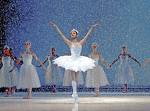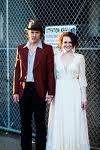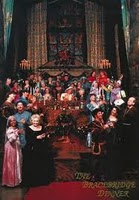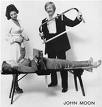 A bit of a roundup before I hop on a plane to Peoria, Illinois, of all places…
A bit of a roundup before I hop on a plane to Peoria, Illinois, of all places…
1. It was weird experiencing the San Francisco Ballet‘s uber-traditional production of The Nutcracker after checking out Mark Morris’ campy-irreverent The Hard Nut at Cal Performances the previous week. It would have probably made more sense to see the productions the other way around. Choreographically-speaking, SF Ballet’s production is much more interesting. The character dances are especially magnetic to watch — incredible leg-work from the trio of men who performed the Russian dance after bursting out of three enormous Faberge eggs. One thing I preferred about The Hard Nut, however, was its use of a real children’s choir. San Francisco Ballet employed a tinny sounding synthesizer for the short section involving children’s voices. This was very disappointing. Surely this company, which is, after all, one of the flagship ballet organizations in the world, could stretch to hiring real singers? I suspect that children’s choirs come cheap. And the vocalists are, on average, small, so they don’t take up too much space on stage or in the pit.
2. Having watched a production of David Greenspan’s gender-bending play, She Stoops to Comedy, at SF Playhouse last night, I’ve come to the conclusion that few playwrights make me feel quite as overtly like a shrink as Greenspan does. The writer has a wonderful way of turning stage conventions on their head and he has a great feel for dialogue and timing. But he clearly uses theater as a way to work out his enormous personal issues. I felt like I had been giz’d over by the time I left the theater last night. The play was quite fun and the cast was good. But She Stoops isn’t as tightly-constructed, hilarious and thoughtful as Greenspan’s Dead Mother, which the Jewish Theatre produced last year.
3. Finally, a shameless plug before I leave (I won’t be blogging for a few days while traveling): VoiceBox, a new public radio about the art of singing and the best of the vocal music scene from the Bay Area and beyond which I am producing and hosting, is launching on January 1 on KALW 91.7 FM San Francisco. The first weekly broadcast airs from 10-11pm Pacific Time and the inaugural show, entitled “why we sing”, endeavors to tackle some fundamental questions about the human voice. You can also catch the broadcast via live streaming on the KALW website. To find out more about the series, visit the VoiceBox website.
It only remains for me to wish you all a songful and restful holiday.

 I was on the 51 bus yesterday traveling between Oakland and Berkeley. Somewhere along College Avenue, an angular young man got on the bus and sat opposite me. He was muttering to himself and looking very shifty. He kept saying, in quite an upper class, tight-lipped colonial era British-sounding accent, “I have a difficult thing to do” and “I have decided they cannot live.”
I was on the 51 bus yesterday traveling between Oakland and Berkeley. Somewhere along College Avenue, an angular young man got on the bus and sat opposite me. He was muttering to himself and looking very shifty. He kept saying, in quite an upper class, tight-lipped colonial era British-sounding accent, “I have a difficult thing to do” and “I have decided they cannot live.” How do you make a work as well-known and didactic as The Threepenny Opera feel fresh? The piece is so often performed and makes such a strong and obvious statement about societal corruption, that any production of the three-hour-plus-long Weill-Brecht magnum opus is bound to fall short of surprises, even if the songs are a hell of a lot of fun to listen to and sing.
How do you make a work as well-known and didactic as The Threepenny Opera feel fresh? The piece is so often performed and makes such a strong and obvious statement about societal corruption, that any production of the three-hour-plus-long Weill-Brecht magnum opus is bound to fall short of surprises, even if the songs are a hell of a lot of fun to listen to and sing. Since the publication of Chris Anderson’s book The Long Tail a few years ago, niche concepts and organizations have become more accepted and even celebrated in culture. The public isn’t so surprised about the existence of tiny splinter groups and weird cultural interests than they used to be. Some niches are nichier than others though. Selling w-scraped oboe reeds made with goldbeater skin or running a dance studio dedicated to a genre from a tiny Pacific island, might seem like losing propositions. But these days — thankfully — these kinds of activities are flourishing, perhaps more than ever before. Hooray for the Internet!
Since the publication of Chris Anderson’s book The Long Tail a few years ago, niche concepts and organizations have become more accepted and even celebrated in culture. The public isn’t so surprised about the existence of tiny splinter groups and weird cultural interests than they used to be. Some niches are nichier than others though. Selling w-scraped oboe reeds made with goldbeater skin or running a dance studio dedicated to a genre from a tiny Pacific island, might seem like losing propositions. But these days — thankfully — these kinds of activities are flourishing, perhaps more than ever before. Hooray for the Internet! My friend and comedian
My friend and comedian  Ever since I first heard about NBC’s new a cappella singing competition,
Ever since I first heard about NBC’s new a cappella singing competition,  In the spirit of catching up and filling in…
In the spirit of catching up and filling in… My alma mater, Cambridge University, is celebrating its 800th anniversary right now. If I were responsible for putting together the celebrations for such an auspicious occasion, I probably wouldn’t do it the way in which the organizers of the Bay Area 800th anniversary party did it.
My alma mater, Cambridge University, is celebrating its 800th anniversary right now. If I were responsible for putting together the celebrations for such an auspicious occasion, I probably wouldn’t do it the way in which the organizers of the Bay Area 800th anniversary party did it.
 Perhaps it’s the war-mongering, economically-difficult times we currently live in, but theatre companies seem to be achieving great commercial success in San Francisco these days with shows that draw inspiration from the black and white movie thrillers and romances of yore to create a new breed of theatrical escapism.
Perhaps it’s the war-mongering, economically-difficult times we currently live in, but theatre companies seem to be achieving great commercial success in San Francisco these days with shows that draw inspiration from the black and white movie thrillers and romances of yore to create a new breed of theatrical escapism. I came across a beautiful if slightly knotty quote yesterday in Thomas Forrest Kelly’s book about classical music world premieres that changed the course of music history, First Nights.
I came across a beautiful if slightly knotty quote yesterday in Thomas Forrest Kelly’s book about classical music world premieres that changed the course of music history, First Nights. With the holiday season upon us, the performers of live theatre, circus, magic, and comedy shows are working their audience participation gambits to the max, despite the fact that most members of the public tend to shy away from being picked to help a magician out with a card trick or do a funny dance routine with a clown. But for those exhibitionists among us who quite like to get hauled up on stage every now and again, especially after having one too many yuletide eggnog cocktails, here are a few pointers to help improve your chances of earning a momentary place in the spotlight:
With the holiday season upon us, the performers of live theatre, circus, magic, and comedy shows are working their audience participation gambits to the max, despite the fact that most members of the public tend to shy away from being picked to help a magician out with a card trick or do a funny dance routine with a clown. But for those exhibitionists among us who quite like to get hauled up on stage every now and again, especially after having one too many yuletide eggnog cocktails, here are a few pointers to help improve your chances of earning a momentary place in the spotlight: Had three classical music concert experiences this weekend, none of them “professional” in the standard sense of the word, but all of them encouraging in the sense that they demonstrate how great musicianship exists at the grassroots level in even the most adverse of financial climates. I’d like to share with you a few thoughts about each one:
Had three classical music concert experiences this weekend, none of them “professional” in the standard sense of the word, but all of them encouraging in the sense that they demonstrate how great musicianship exists at the grassroots level in even the most adverse of financial climates. I’d like to share with you a few thoughts about each one: